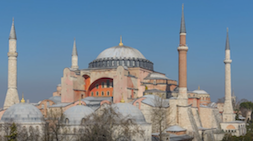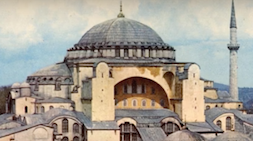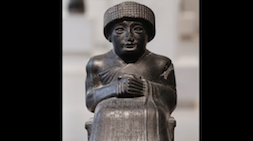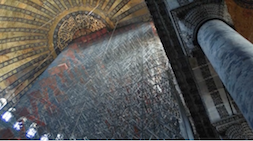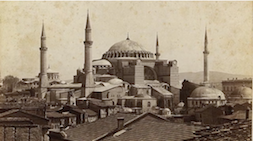Analyzing Objects
Overview
The modules in Methods present case studies that demonstrate how scholars interpret different kinds of historical evidence in world history. In the video below, historian Lawrence Butler analyzes sources related to the Hagia Sophia, including an image of the cathedral of the Byzantine Empire in Constantinople, (present day Istanbul), and an architectural drawing of the building’s floor plan. The Hagia Sophia was built in the early 6th century by the Emperor Justinian and stands today, almost 1,500 years later, despite earthquakes, wars, and revolutions. The Hagia Sophia began its life as a Christian church, became a Muslim mosque and is now a museum. Buildings such as the Hagia Sophia offer us wonderful opportunities to investigate such things as evolving religious practices, architectural and engineering techniques, and the relationship between a building and political power. The primary sources referenced in this module can be viewed in the Primary Sources folder below. Click on the images or text for more information about the source.
Video Clip Transcripts:
1) How did you first get interested in the Hagia Sophia?
I’ve always loved architecture and usually when I encounter a new architecture, I have some sort of instinctual reaction to it. When I encountered Byzantine architecture in a college course, I didn’t get it. And I was interested in that. The aesthetics of the style don’t conform to what I was brought up on thinking of as good architecture. I grew up in the modernist era, and you want a building that shows its structure, that expresses its materials clearly. Byzantine architecture does the opposite. Part of the fascination is that it’s very difficult to understand what holds the building up when you first encounter it. You really do need diagrams and some explanation, I think, to understand the building. And that’s part of the interest in studying it. And that’s part of the interest in pouring over diagrams. When I started traveling in college, I made a point to get to Istanbul, found the city to be absolutely fascinating, and continued to be baffled by the aesthetics of Byzantine architecture. And in a funny sort of way that led me into studying it.Video Clip Transcripts:
2) What do you first look at when you study a building?
I think the first thing I notice is the simple geometry, the logic of the structure. The building is symmetrical; the building is not symmetrical. There’s been an exercise in squares and circles or maybe the architect is interested in something else. If there are striking irregularities, I assume that there has been alteration to the building over the years, which is almost always true in an old building. I’m also aware, though, that floor plans are, to some extent, a lie. And one of the things you do have to be critically aware of is to what extent a floor plan has been cleaned up. Most old buildings are not perfectly straight or perfectly round. Most old buildings have distortions. They have additions. There are irregularities. If you see none of those in a plan, you suspect you’re dealing with something that has been cleaned up and that’s fine. Then you appreciate that plan for its logic. If however, you encounter a plan that has lots of irregularities, then you appreciate that plan as someone’s attempt to show how the building looks today. I take great delight in the plan of this building. It is quite complex. When I look at it and think about the poetry of the design, and it is a very poetic design, what I’m struck by is the cascade of circular forms. From the great round dome in the center that was 100 Roman feet in diameter, to the two great half-domes buttressing it, to the six smaller half domes buttressing those, and so on and so forth, forming a cascading pyramid of circles. And even today, when one visits and the place is a little bit grimy and a little bit busy with traffic, when one looks up, one is struck by the harmony of the circular forms and it is really quite astonishing. In most cultures, a dome structure was understood in some way to be a metaphor of the dome of heaven. And when you’re in the Hagia Sophia where the dome is so large and so far above you, lighted with its many windows, I think even the dullest audience is going to have some sort of notions of the heavenly metaphor inherent in the design. The eye is drawn upward and then you are drawn around. An important part of any medieval church is the quality of sound and this is something that orthodox architects in Russia and Greece still study today. An important part of the experience when this was a church would have been the quality of sound and we have a number of travelers’ accounts that attest to this. Famously, when the Byzantines sought to convert Russia to Christianity they brought the ambassadors to Hagia Sophia and presented them with a high church service. The ambassadors went back to Russia and reported, “We did not know whether we were in heaven or on earth; the experience was so beautiful.”Video Clip Transcripts:
3) How do you analyze a floor plan?
A floor plan is the footprint of a building. If you imagine a building that was cut off exactly at ground level and then viewed from above, that’s what a floor plan is. To read a floor plan, you do have to be clued into a few conventions that people have used in drafting them. Generally, solid lines, either heavy black lines or solid black filled areas, represent where masonry has been cut through, conceptually. Open space represents open space. Dotted lines are often used to indicate not what’s happening at ground level, but what’s happening up above at the ceiling level. Thin single lines are traditionally used to show changes in the floor itself. For instance, a set of steps will be represented with a set of single lines indicating steps. The trick, then, is to play this back and forth against a photograph of the exterior or the interior until they can begin to see the relationship. One of the things that we don’t know as much about as we would like to is what exactly plans were like in antiquity. We really just don’t have very many. When we do have floor plans from antiquity, I’m always struck by how easy they are to read today. When you have small gaps in a wall, for instance, it’s a door. When we look at plans from antiquity—I’m thinking of plans from ancient Sumeria, for instance, of temples carved in stone—there’s a gap, it’s a door. We have the archaeology that demonstrates it. So, to some extent, a plan is intuitive, I think, because they do seem similar over the centuries. But then some conventions change over time and we have to learn what those are. A floor plan is pretty much intuitive once you learn a couple simple rules: thick lines are walls, openings are doors, and that sort of thing. I’m looking at a plan here of the Hagia Sophia that is mostly an accurate representation of the shape of the building today, minus all of its additions and plus a few features that probably have not been present since the 15th century. And nowhere on this plan do I see any of that explained. The plan I’m looking at right now gives almost no indications of what is actual and what is archaeological. There’s one exception. There are a few walls that are sketched in with light lines and, now, that’s a convention that means there was once a wall there that is now present only in foundations. Other than that though, there are features here that simply don’t exist anymore and haven’t in hundreds of years, and there's no indication that they’ve disappeared.Video Clip Transcripts:
4) How do you introduce a building to students?
When I introduce a building, I try to show the students that a building is a complex thing that has a long history. It has its initial period and then it has its subsequent history by other users, and these are all part of the story of a building. I look at buildings as primary-source documents. We look at the initial purpose. In the case of the Hagia Sophia, that would be a church. It was initially a Christian church. We look at the patron who wants the building, who paid for the building. And often some of the most interesting questions and answers arrive from a study of the patron. We look at the architect of the building, as far as we know or can discern. By studying the architect, we can get at cultural assumptions. We can get at technology of the period. We can get at education of the period. The more we know about an architect, the more we understand the purpose of the physical form of the building that resulted. It’s often difficult to consider how a building has been used because we don't always know. In the case of a building as old as the Hagia Sophia, for instance, liturgies have changed over the centuries and, for that matter, the whole function of the building has changed over the centuries. Many scholars who study architecture, in fact, focus on trying to reconstruct the original function by studying plans and furnishings and written sources to understand, well, “what exactly happened in this building?” Another important consideration in studying buildings is construction—construction methods, construction materials. What was the state of engineering when this building was designed and constructed? Did they design it conservatively or, as in the case of the Hagia Sophia, did they design way beyond the known technology of the time? Were innovations successful or, in fact, did things fall down? The original dome of the Hagia Sophia, for instance, was probably too flat and the initial construction period too rapid for the building to be stable and the first dome collapsed. This is not unusual in the history of medieval architecture. A student looking at a plan should be able to discern fairly quickly, “Is this a single space or is this a complex space?” By noting the doorways, a student should be able to say, “Well, where do you enter? Is there a single entrance? Is there a single access? Or are there multiple entrances? Is the access straight in or is one led around?” The implication there is, does the architect want you to experience the building instantly, directly, in its whole. Or does the architect want you to experience a sequence of spaces, either for aesthetic reasons or for defensive reasons? A plan should be able to tell the student whether a building is intended for a single function or for multiple functions. If, for instance, there are subsidiary spaces with their own entrances, that’s a pretty good clue that they expected lots of different things to happen. A plan can also tell a student whether the main space, even if it’s symmetrical, is going to be a complex kind of a space or a simple one. Is it a square or is it a series of complicated shapes. And, in the case of the Hagia Sophia, it’s very complicated. And it’s fair to assume the experience of the building is going to be a little bit of bewilderment as the shapes sort themselves out. When one studies a building, one also wants to know what furnishings were involved. One of the great losses in the history of art and architecture, for instance, has been textile. Before modern times, textile pervaded the universe, the visual universe of most people in most parts of the world most of the time. Textiles don’t last. And so when we look at an old building, we often have to ask questions like: Were there curtains? Were there carpets? What were people themselves using the building wearing? And to what extent was that understood by the architects?Video Clip Transcripts:
5) How do you teach students to analyze a building?
This building is a museum now, which means that its main function is to sit there and be visited. So its immediate surroundings are its own gardens, and then bus lots, city streets, tourists, kiosks, restaurants, that sort of thing. But if you go just over the hill to a similar building, say the Sergius and Bacchus Church, which is now the Little Hagia Sophia Mosque, Kucuk Hagia Sophia, it’s a working mosque now, converted from a church. The old men of the neighborhood will spend all day sitting on the front porch, conversing. People have shops immediately adjacent to it. They may come in and out for prayers. People have grown up and lived in that neighborhood with that mosque at the center all of their lives, and so they have a very different view of the building than I, as a scholar from another country, would have. When I teach architecture, I usually start with photographs and I like to show a building in its surroundings. But to analyze the structure you really have to look at the diagrams because that's the way an architect begins. An architect thinks schematically. So the first thing that a floor plan can show you is how the architect thought about the building. I, first of all, try to make sure that they can understand the relationship between a photograph and a scheme. And I do walk them through how to read a plan at the beginning of a course. I also use a variety of other architectural diagrams—sections, elevations, and isometric drawings—which give different kinds of insight into the building. When I present this to students, what I do is I pick out an obvious feature. For this building, it would be the dome. For instance, I can show an interior, or for that matter an exterior picture, a photograph of the building and then I can also very easily pick out the dome in a plan. It will always be represented in a dotted line, a circle in the middle of the building. It's as simple as putting two slides next to each other and saying, “See this. There it is on the plan.” Smaller features are harder to find. An easy one I see here is columns. Columns are very easy to identify, both in plan and in picture. In a plan, a column looks like a polka dot. I also, of course, don’t just present the building as a floor plan or as an exercise in logic. When I teach any building, and particularly any building associated with a spiritual tradition, I try to teach the building as a living entity in which things happen. I try to give them some sense of the original lighting. Is this a bright space, a dark space? And I try to walk them through, following the sequence of spaces they might have followed as, say, a worshiper in a church like this in the 6th century. First you’re in the low narthex; you come through a door. There is this rather baffling side space you have to negotiate and then you are suddenly in this enormous and very tall space with a huge dome floating overhead. So I try to give them some sense of the experience of walking through this building, which is hard to do with slides because architecture is a spatial thing. And much of the experience of architecture depends on your moving through a three-dimensional space. What I do, of course, in my courses is assign them architecture projects where they do just that. Where they go visit a sacred structure and I have them look at all of these things: the plan, the shape of the building, the exterior, how it sits in its location. I have them learn how the ceremonies take place inside and think about how the building was arranged for those ceremonies. I have them think about the objects that would be in there and the sorts of decoration that are appropriate for that spiritual tradition.Video Clip Transcripts:
6) How does the history of this building shape your analysis?
When I teach the Hagia Sophia, I tend to teach a lot of Christian theology along with it, because it’s important to understand that the building is more than just a church. It was also intimately connected with an imperial government with its own ideology and that, in turn, was deeply rooted in Roman law, in Greek philosophy, as well as in Christian theology. And all of these things bear upon the form that that building took originally and the way it evolved over time. When the Ottomans took over the city in 1453, they immediately reconsecrated the building as a mosque. Interestingly, they retained the same name, Hagia Sophia, phonetically. It doesn’t mean anything in Turkish; it’s just a geographical place. It raises a question of why, and it’s not true of any of the other converted churches. None of them carried their names over from the Christian into the Islamic period. I think simply because the building is so enormous that it has its own identity and its own name. Istanbul was, and still is to some extent, a very multicultural city and so lots of different populations, Greek and Jewish and Armenian as well as Turkish people, would have had a name for the building but it did carry on. When one goes to the building today, it’s sometimes hard to conjure up the Byzantine Greek Christian context for what one sees. And this in itself is an interesting problem in studying Byzantine architecture in Istanbul. Istanbul today is predominately a Turkish, Muslim city. The historic monuments from before the 15th century are predominately Christian and Greek. There is some political tension involved in those monuments and sometimes this can affect issues of restoration, issues of naming, or even just the sheer understanding of what the older Byzantine monuments meant originally. The building is politically very, very sensitive, which is why—primarily the reason why—it’s a museum today. When Kemal Ataturk had the building secularized in the 1930s, he was, in effect, removing it as a very potent symbol of Islam in his new secular republic. One does still occasionally today find old men climbing over the barriers to do their prayers in front of the mihrab. There is a small section of the building that has been set aside for Islamic prayer, though the guides don’t like to point it out because officially the building is secular. There are often church groups that come in on tours and will do an impromptu church service in one corner or another, in effect reconsecrating the building to their own satisfaction. And this is part of the history of the building and part of what I think a sensitive restorer, archaeologist, historian, student of the building needs to respect. And it’s part of the beauty of the building as well.Video Clip Transcripts:
7) What other sources do you use?
When we study the building, we can use primary sources. There are a great many of them available. When I study the building, the first thing I turn to is the writings of Procopius, who was the official historian of the Emperor Justinian, the patron of the building originally. Procopius gives us the official view of the building’s construction. He talks about the riots that led to the destruction of the previous cathedral and the determination of the Emperor to rebuild it. He gives an interesting, if not entirely comprehending, account of the construction. There are places where he steps aside and says, “I don’t entirely understand these matters, but people assure me that this is how it was built.” In general, he’s a reliable historian of the construction of the building, we think. There are also some fascinating primary sources from the same period that give a somewhat more mythological spin to the early construction, the intervention of angels and suchlike. Those are interesting as well. They tell us about the popular understanding of the building’s significance in its own time. Over the centuries numerous Byzantines and also outside travelers commented on the building extensively. It was the main theater of action in the city. Revolutions were begun there. Great events in the city’s history and the empire’s history were played out there. Individuals, many individuals, have been closely associated with the building and all of this is documented in the primary sources. And yet, still, there are large gaps in our knowledge. There are some periods, for instance, the iconoclast period of the 8th and 9th centuries, where we have only spotty primary sources remaining to us, which is a little frustrating to the architectural historian because it also seems from studying the fabric of the building that major alterations were carried out then. So, for some periods we understand what was going on. For other periods, we have to rely on the archaeology of the building.Download Full Video Transcript
Primary Sources
Credits
Lawrence Butler is a medievalist with particular focus on Byzantine and Islamic art and architecture. A sometime resident of Istanbul, Turkey, he has published on the Hagia Sophia and related sixth-century structures, on the history of American scholarship in the eastern Mediterranean, and on the mosques of East Asia, Chinese art, and material culture of the Silk Road. His teaching interests span the medieval Eurasian world from Iceland to China, with special attention to trade connections, cultural property issues, and the Silk Road.
Grateful Acknowledgement is made to the following institutions and individuals for permission to publish material from their collections:
Dumbarton Oaks
Turizm.net
Lawrence Butler

